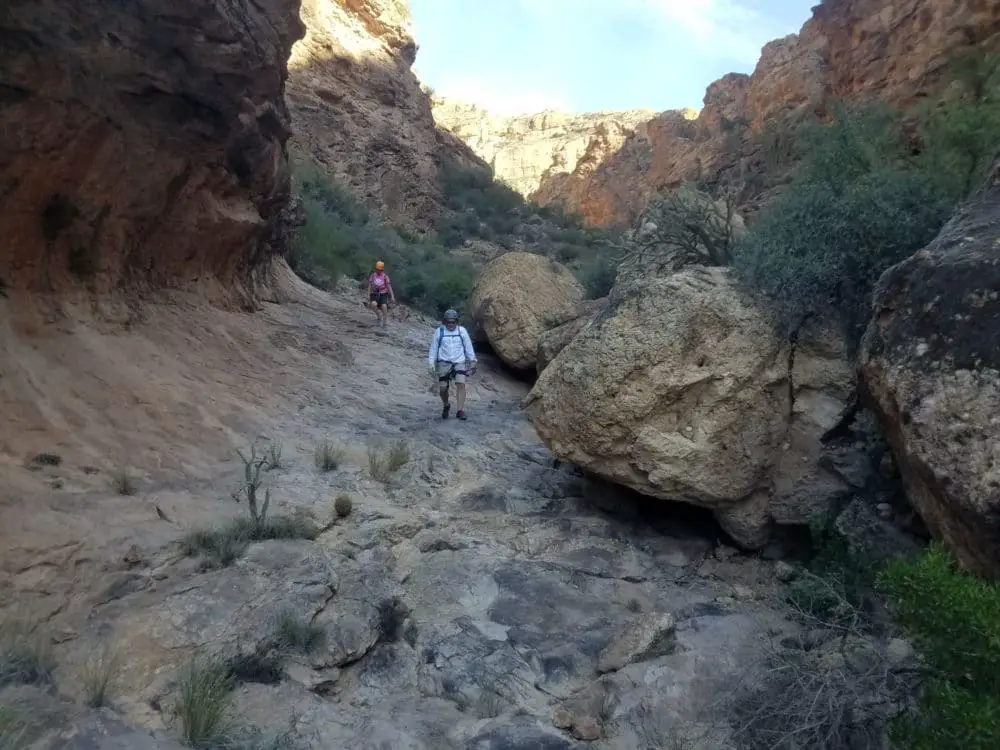Canyoning (Canyoneering in the US) shares a lot of the same risks as hiking, rappelling, and swimming. Some of these risks can be mitigated by preparing ahead with special gear, and some are largely unavoidable like falling rocks or a flash flood. Canyoneering is a backcountry activity, and should be treated as such.
In many more popular areas, you can easily hire a guide service to take you through a remote canyon. Canyoning with a guide, in places like Zion National Park , Utah or Kawasan Falls, Cebu, is much safer than going in a self-guided group. The guides are extremely familiar with every single section of the canyon, and are prepared and trained in first aid and self-rescue techniques. Canyoneering with a guide removes a lot of the manageable risks, leaving only the possibility of freak accidents.
, Utah or Kawasan Falls, Cebu, is much safer than going in a self-guided group. The guides are extremely familiar with every single section of the canyon, and are prepared and trained in first aid and self-rescue techniques. Canyoneering with a guide removes a lot of the manageable risks, leaving only the possibility of freak accidents.
Is Canyoning Safe? Even with a guide, Canyoneering is still dangerous. If things go wrong in the backcountry, it can take a lot of time to either escape or to be rescued. In some cases, people may not even come looking for you until too much time has passed. It is very important to understand the risks, as outlined below, and to know how to prepare for them.
Common Canyoneering Accidents-
- Flash Floods
- Heat Exhaustion
- Hypothermia
- Drowning
- Falling
- Rockfall
- Pathfinding Errors (Getting Lost)
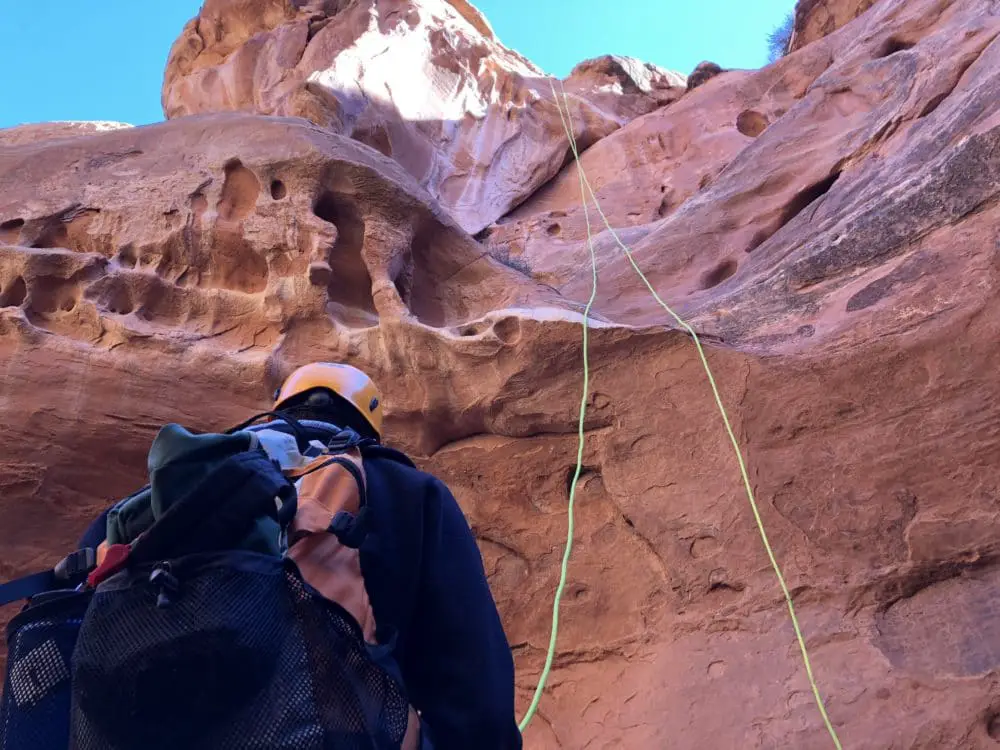
See Also: What is Canyoneering?
Is It Safe to Go Canyoning with Commercial Guiding Services?
There are a lot of advantages to hiring a guide service to take you canyoneering. The prices are generally pretty low compared to other adventure activities (I mean come on, the guides get PAID to go canyoneering!). In a lot of places you can spend a half-day canyoneering for just over $100USD. They provide you with all of the gear you need, including technical gear and a wetsuit (sometimes even snacks). This is the best way to learn about canyoning, and the best way to try it out if you don’t already know people who do it frequently.
If you are new to the adventure sport, a guide will help set up the rappels or even teach you how to rappel. If there are any treacherous conditions or dangerous spots (like keeper potholes
or even teach you how to rappel. If there are any treacherous conditions or dangerous spots (like keeper potholes ), the guides will point them out and teach you how to avoid them. It’s best to make sure there are at least two guides per group. In the event of an accident involving a guide, someone needs to know how to rescue the group. This isn’t as necessary in highly-trafficked places.
), the guides will point them out and teach you how to avoid them. It’s best to make sure there are at least two guides per group. In the event of an accident involving a guide, someone needs to know how to rescue the group. This isn’t as necessary in highly-trafficked places.
Hiring a guiding company to take you canyoneering eliminates the risk of navigational errors and getting stuck, and ensures you have all of the gear that you need to successfully descend the canyon. One of the best advantages, as someone who has done my fair share of canyons, is to be able to hire a guiding company when I am travelling so I don’t have to try and pack all of my own gear. The guides can often tailor an experience especially for you, depending on your level of comfort.
The main downside to hiring a guide is that it takes away a lot of the allure of canyoneering. With a guide, the area around the next corner is no longer unknown, and the challenges are more scripted. It’s definitely best to hire a guide when first getting into canyoneering, but as you progress and develop the skills and training you need you will be able to lead your own groups. While self-guiding is more dangerous, it can still be done safely with the proper training and preparation.
you will be able to lead your own groups. While self-guiding is more dangerous, it can still be done safely with the proper training and preparation.
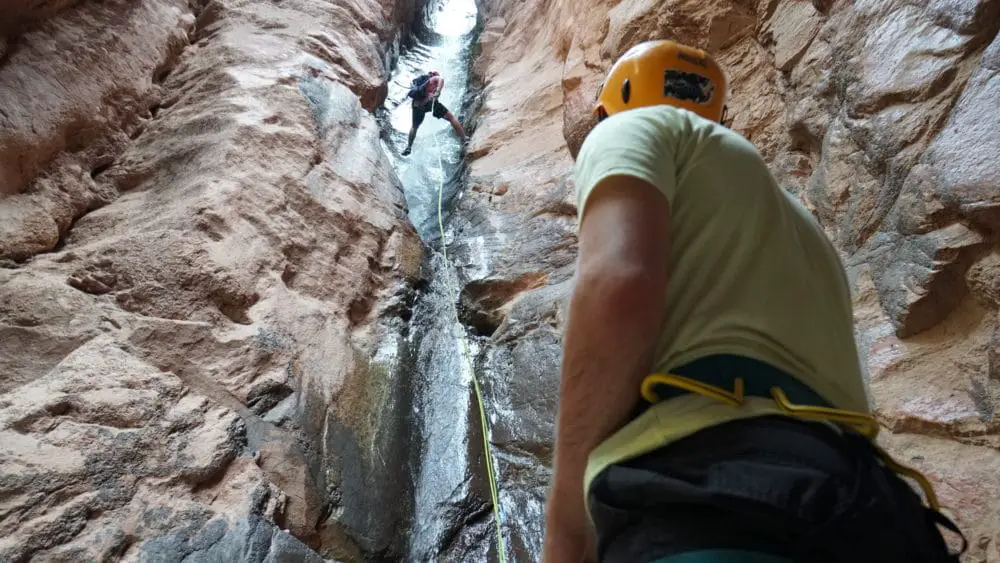
Is Self-Guided Canyoneering Safe?
Every year there are a handful fatalities in remote canyons throughout the world. Often they are due to flash flooding, but other emergencies occur as well. One of the main reasons disasters happen so frequently is that rescues are so difficult due to the remote and isolated nature of canyoneering. If there’s a rockfall or unexpected exposure to the elements on a well-trafficked hiking trail, someone will be there to call search and rescue and render first aid. If an accident happens deep in a canyon, it could be days before another group passes through to find you.
If an accident strikes a single member of a crew, someone will have to continue to the next escape in order to contact search and rescue. In a canyon you can’t just turn around and go back, or climb out the side whenever you want to. Once you’re in the canyon after the first rappel, you are committed to finishing! With the dangerous conditions found in most canyoneering trips, groups need to have the technical expertise and preparation necessary to self-rescue.
See Also: Our Recommended Emergency Equipment for Canyoneering
for Canyoneering
Canyoneering Safety Tips
I like to look at the risks in canyoneering as either manageable or unmanageable. There are some you can plan for, and others where there’s just not much you can do. Some risks are inherent in the sport, and some can be mitigated with training and planning ahead. For example, there’s nothing you can do to avoid a rockfall, but wearing a helmet can definitely lower the risk of serious injury.
The information provided below is not meant to be a comprehensive safety training, but is intended to be a starting point to show you what you need to learn and know before going out on your own. I recommend taking training courses and getting certified from a reputable source.
from a reputable source.
Safe Canyoning – Avoiding Manageable Risks
Every canyon promises different risks. Some are comprised of tight spaces with long drops and others have difficult downclimbing sections or a long approach. In many desert environments, canyoneering season is year-round, so you have to be prepared to face varying levels of water flow and temperatures across the spectrum. Here are some of the most common canyoneering accidents and risks, and how to successfully avoid them.
Navigational Errors
Even Dora the Explorer brings a map everywhere she goes. Canyons are notoriously difficult to follow, and with no way to follow your tracks back upstream to the car, it’s crucial to have a map and know how to read it. You can pick up a topographic map from just about any ranger station or visitors center for free, or easily buy one in the closest town or online.
You need to understand how to read a topographic map (topo). The contour lines show elevation changes, which will help you pinpoint your location- as well as the entrance and exit to the canyons you explore. It’s often helpful to consult with the other members of the group to make sure you are all on the same page. There usually aren’t trails, especially near the exit of a canyon. If you miss the designated exit you could potentially continue down a subsequent canyon you aren’t prepared for. Pathfinding errors can be deadly.
Prepare well ahead of time and plot out your course. Check to see if there is a guidebook for the area, and take pictures of the pages ahead of time if you don’t bring it with you. Additionally, you can find beta information on lots of different canyons on various blogs and wiki sites. Conditions change frequently, and memories aren’t perfect, so don’t rely on them solely. I always print the beta from as many sites as I can and bring two copies with me through the canyon, plus one on my cell phone. Two copies, because I always end up jumping in the first pool with the first copy in my pocket!
 The other crucial step that I take to mitigate the risk of getting lost is to prepare with information on my cell phone. The most useful app for me is actually Google Maps. Download the area ahead of time (definitely no service in a canyon) and google can usually track your progress while you are offline. Whether it’s magic or satellites, I don’t know, but it works surprisingly well. The satellite view can be helpful because it can highlight landmarks. Save waypoints from the beta you find online, like the entrance and exit points, as well as where you park the car.
The other crucial step that I take to mitigate the risk of getting lost is to prepare with information on my cell phone. The most useful app for me is actually Google Maps. Download the area ahead of time (definitely no service in a canyon) and google can usually track your progress while you are offline. Whether it’s magic or satellites, I don’t know, but it works surprisingly well. The satellite view can be helpful because it can highlight landmarks. Save waypoints from the beta you find online, like the entrance and exit points, as well as where you park the car.
I also like to use the app Fatmap to select my route. It’s as close to hiking the trail ahead of time as you can get, and it is really nice to be able to get a preview of what is coming.
to select my route. It’s as close to hiking the trail ahead of time as you can get, and it is really nice to be able to get a preview of what is coming.
Tell someone where you are going and when you will be back- I read a story of a man in the Phoenix area in 2018 who was out hiking and fell down a mineshaft. He broke both of his legs in the fall. Fortunately, he’d told a friend where he was going, and his friend sent for help the next day when he didn’t show up. By the time rescuers found him, he’d killed three rattlesnakes down in the mineshaft! The story would have ended very differently if he hadn’t told anyone his plans.
I always email my dad my plans, along with my expected route and a time to call in the cavalry if he hasn’t heard from me. Be generous with that timeframe, but realistic as well. Depending on the time of year and length of the canyon, you may not survive an unplanned night out. I’ve also been known to leave a sticky note on my computer monitor at work with the name of a canyon so they know where to look for me if I don’t show up on Monday!
Heat Exhaustion/Hyperthermia
Living in Arizona, I’m used to everyone using the phrase ‘it’s a dry heat’ to describe out wonderful desert. Temperatures in the desert can rocket up above 110 F (43 C) during the heat of the day. At that temperature, you lose fluids rapidly and start cooking. With canyoning, the biggest danger can come on the approach or exit hike which are usually completely unprotected up on the surface. The canyon itself is shaded and may have water sources to cool you down.
Drink more water than you think you need, and eat something to replenish electrolytes. Pay attention to your own body, and keep an eye on other members of the group. The heat can sneak up on you, especially when your preoccupied with pathfinding or exploring. If you notice someone with abnormally pale or flushed skin, or if someone begins to experience a headache, nausea, or dizziness, find shade and water. It’s important to have a strong understanding of First Aid, and I recommend taking a Wilderness First Responder (WFR) course so you’re ready when something happens.
(WFR) course so you’re ready when something happens.
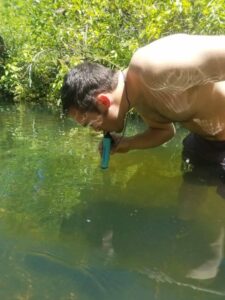
Some canyons may have plenty of flowing water you could treat and use as a drinking source, while others may be bone-dry most of the year. You never know for certain what the conditions are like, so unless you’re taking on a Class C canyon, bring all of the water that you’ll need. If there is water available in the canyon, filter it before you drink it. I wrote about the purifying systems I like most for canyoneering, and you can read it here .
.
Give extra thought and preparation to the clothing that you bring canyoneering, taking care not to dress to warmly, but to still cover up to avoid the sun. I wrote an article detailing What to Look for in Canyoneering Clothing .
.
Heat exhaustion can quickly sap your energy and mental capacity, so it’s really important to treat it and get out of the sun as soon as you can. If left unchecked, it can turn into heat stroke, which is much more severe- especially in the backcountry.
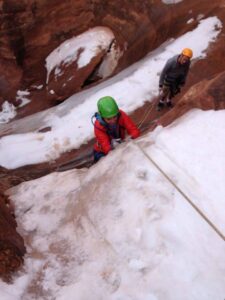
Hypothermia
Canyon runoff often comes from melting snow, especially when canyoneering in early springtime. Dropping into a pool of water can be as frigid as a polar plunge into a frozen lake. Some canyons actually freeze over during the winter. Even during the summer, when temperatures soar above 100 F (38 C), water temperatures can remain very cold.
In addition to the melting snow temperatures, steep canyon walls prevent any sunlight from reaching the bottom and warming up either you or the water. Cold water chills you to the bone much faster than cold air does. Once you get wet, it’s difficult to warm up again without the sun. Take a look at our guide to the best clothing to wear canyoneering , and dress according to the season and the canyon.
, and dress according to the season and the canyon.
Take care to avoid the water if possible, and limit the amount of time spent wading and swimming in it. Techniques like stemming and chimneying will help keep you above the water during narrow slots. In case of a situation like a keeper hole, don’t send multiple people into the pothole unless you have to, and pull them out while you strategize. More information on how to escape a keeper pothole in this article .
.
For a Class C or Class B canyon you will probably want to bring a wetsuit along. Do the approach in your regular clothes, and then change into the wetsuit when you get to the first unavoidable water. A wetsuit keeps you warm by trapping a little bit of water close to your body so your body heat warms it up.
Take it off after exiting the last water section and change back into dry clothes. A wetsuit acts as a refrigerator once you exit the water, so don’t spend too much time wet. Depending on the canyon and the season, you’ll want a shortie or a full length wetsuit, or possibly even a drysuit. For more information on wetsuit thicknesses and which ones we recommend, read this post .
.
In some shorter canyons with knee-to-waist deep water, one member of the group can ferry the others across on their shoulders so that only one person gets wet. This keeps morale high and is especially helpful for newer and younger members of the crew like kids and young teenagers. Don’t do this until you test the footing first- if you fall with someone on your shoulders, someone could hit their head and you both get drenched.
You especially risk hypothermia when you stop moving. Do some jumping jacks (star jumps) or other light activity to get your blood moving and to keep warm. As with heat exhaustion, keep an eye on the other members of the group, as the cold can sneak up on you. You burn a lot of energy shivering in the cold, so bring high-calorie snacks and eat them throughout the canyon.

I always keep an emergency blanket in my kit, and have had to use it several times. They work well to reflect and trap heat on a freezing crew member, and fold up to the size of a wallet. I also recommend bringing a firestarter, though it’s usually difficult to find fuel in the bottom of a canyon. Read through our list of what to keep in your emergency kit , and decide what else you need.
, and decide what else you need.
Cliff Jumping
One of the most taught rules in a canyoneering course is to never jump into water when you can’t see the bottom. The problem is, cliff jumping is a whole lot of fun. I add the caveat, never jump into water until someone has depth tested it that day. Conditions change overnight. Just because you jumped in this section last year, or because everyone jumps there does not mean it’s safe to jump today.
Flash floods tear through canyons, hauling loads of dirt and even trees and logs. Imagine jumping 30ft (10m) and landing on a vertical log a few inches below the surface. Always send someone down on rappel first to check the depth of the water before jumping, and you won’t have to worry about broken ankles, legs, or worse.
 Stemming and chimneying techniques are used to bridge gaps, and can be used to ascend and descend tight slots. If you slip while bridging a slot over water, you risk twisting or breaking an ankle. If you fall while chimneying up really high above a tight slot, you can get wedged into the slot and get a combination of road rash and broken bones.
Stemming and chimneying techniques are used to bridge gaps, and can be used to ascend and descend tight slots. If you slip while bridging a slot over water, you risk twisting or breaking an ankle. If you fall while chimneying up really high above a tight slot, you can get wedged into the slot and get a combination of road rash and broken bones.
Wear the right canyoneering shoes so you have solid grip against the wall, and practice these techniques low to the ground before going up high. I recommend getting a good pair of elbow & knee pads, like the ones listed in our recommended gear page
so you have solid grip against the wall, and practice these techniques low to the ground before going up high. I recommend getting a good pair of elbow & knee pads, like the ones listed in our recommended gear page . Falls also happen when downclimbing, so practice using partner capture techniques to spot each other rappel off of a meat anchor
. Falls also happen when downclimbing, so practice using partner capture techniques to spot each other rappel off of a meat anchor to prevent dangerous falls.
to prevent dangerous falls.
Another risk inherent to any cliff edge is slipping, tripping, and falling (or even being pushed, depending on the group you’re with). Climbers and canyoneers go to the extreme a lot of the time, asking if you would be okay if you were to randomly faint near the edge. If the answer is no, do something about it! I highly recommend tying into the anchors, or to a point nearby the anchors before connecting into the rope for your rappel.
A lot of rappelling accidents happen during the initial set up and while each person ties into the rope. Use a PAS , or some other kind of tether to tie yourself in whenever you’re near the edge. You can learn more about rappelling risks in our article about the Top 10 Most Common Rappelling Accidents
, or some other kind of tether to tie yourself in whenever you’re near the edge. You can learn more about rappelling risks in our article about the Top 10 Most Common Rappelling Accidents .
.
Drowning
Some canyons require a lot of swimming and treading water. Class C canyons actually have flowing water, which introduces even more risk into the situation- it can be like whitewater rafting without the raft. Swimming with a heavy pack really makes staying afloat more difficult. Wear your pack on one shoulder while swimming so you can shed it if you go under. Better to lose your gear than your life.

I recommend bringing a small inflatable pool floatie for long swimming sections, or if you’re less than confident in your swimming abilities. Kayaking companies sell big dry bags that float and keep your gear from getting wet. These work great for canyoneering, but can be expensive. I bought a couple of 5L and 10L dry bags, and simply put them inside my regular big canyoneering packs. They make my backpack float, so it acts as a buoy instead of an anchor. Our Recommended Gear Page lists the best backpacks and dry bags for canyoneering.
lists the best backpacks and dry bags for canyoneering.
The water can be very, very cold, making swimming difficult. In addition to the cold water and the heavy packs, you also need to keep an eye out for whirlpools or sieves, and underwater obstacles in flowing water. The current can drag you under and trap you against rocks or logs. Look for hints on the surface that one of these treacherous conditions exists. Learn how to escape keeper potholes with this guide.
Safe Canyoning- Managing Unavoidable Risks
Some canyoneering risks just can’t be completely avoided. The tips below will help you to manage and lower these inherent risks. Canyoning is an adventure sport practiced in the backcountry, so all things can’t be controlled- plus, that would take some of the adventure out of it!
Flash Flood
The most infamous danger in canyoneering is a flash flood. Flash floods take the lives of canyoneers every year, and these stories capture news headlines. I remember searching for videos of flash floods online several years ago, and was shocked to only find a handful. People just don’t survive them. In a matter of just a few minutes, and only a few inches of rain, a dry slot canyon can turn into raging river chock full of mud, logs, and rolling rocks.
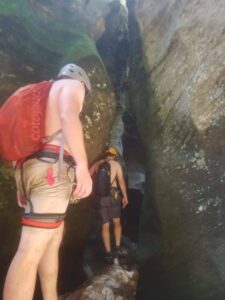
I remember reading a story a few years back about a popular swimming hole that wasn’t even in a very narrow canyon. A rainstorm 8 miles upstream caused a 40ft wide, 6ft high wall of water. The poor victims had zero warning, and the rescue crews didn’t find the last body until two days later.
The point is, there is little you can do once the rain starts falling. The only way to avoid flash floods is to avoid entering the canyon if there’s even the slightest chance of rain in the area. Check the weather forecast, and monitor the skies during your trip. If it does start to rain, get out of the canyon as fast a possible, or at least get up as high as possible.
Rockfall
Another highly unavoidable risk is rockfall. Canyons are strewn with random boulders and chockstones that, more than likely, have broken off of the walls and ground over the years. Especially in softer rocks like sandstone and limestone, chunks break off and can cause serious injuries. The most famous example of this comes from Aron Ralston as portrayed in the film 127 Hours. Rocks shift, and you don’t want to be on the bottom of one when it comes tumbling down.
Take care when setting up a rappel to clear away any rocks that may be dislodged or kicked off of the edge. If a falling rock hits a belayer or rappeler, the results could be disastrous. The best way to lessen this risk is to always wear a helmet and to test anchors and climbing holds prior to fully committing.
Equipment Failure
Climbing and Canyoning equipment is extremely robust, and is always designed to withstand a lot more than you generally throw at it; however, freak accidents do happen. Most accidents I’m aware of happen when someone misuses equipment or sets it up wrong. Gear designers do their best to eliminate the probability of user error, but some risks persist, like cross-loading a carabiner .
.
Ropes fray and wear out, and often don’t provide any warning when they finally break. Keep an eye on the rope near sharp edges, and check it thoroughly prior to each use by examining the sheath and feeling the core for any breaks. A falling rock can sever a rope or cause a core shot. Make sure to let the rope dry out completely at home before packing it away, as moisture and mold can weaken the fibers. When it comes time to replace your rope, read through our ultimate guide to selecting a canyoneering rope .
.
Believe it or not, hardware like carabiners and belay devices can fail too. Although I’ve never seen it happen, a carabiner can develop hairline cracks if dropped off of a cliff onto rock, or in other high-impact situations. Check your gear before descending the canyon, and do your best to take care of it. Rappelling in wet and sandy conditions will wear through a belay device like an 8 ring surprisingly fast, so be ready to replace them as needed. Here are some of the belay devices and carabiners I like best for canyoneering
surprisingly fast, so be ready to replace them as needed. Here are some of the belay devices and carabiners I like best for canyoneering .
.
Obscure Risks
Another serious risk, though very rare, is contracting a water-borne disease. Canyon water (stew) is often stagnant, and disgusting. Lots of different strains of bacteria inhabit the water. Potholes can contain bacteria that is harmful if ingested, and that is harmful to the skin as well. Avoid putting your head under the water whenever possible, and shower off as soon as you can afterwards.
I’ve come across a lot of different poisonous creatures while canyoneering- mostly snakes and scorpions. Keep an eye out for rattlesnakes and scorpions especially. I came across my first coral snake last year, and was reminded of something my wife’s mom said once- “Red touches yellow, run like hell. Red touches black, run like hell.” Pretty sound advice! Don’t bother them and they won’t bother you. If you are bitten, get to a hospital as soon as possible.
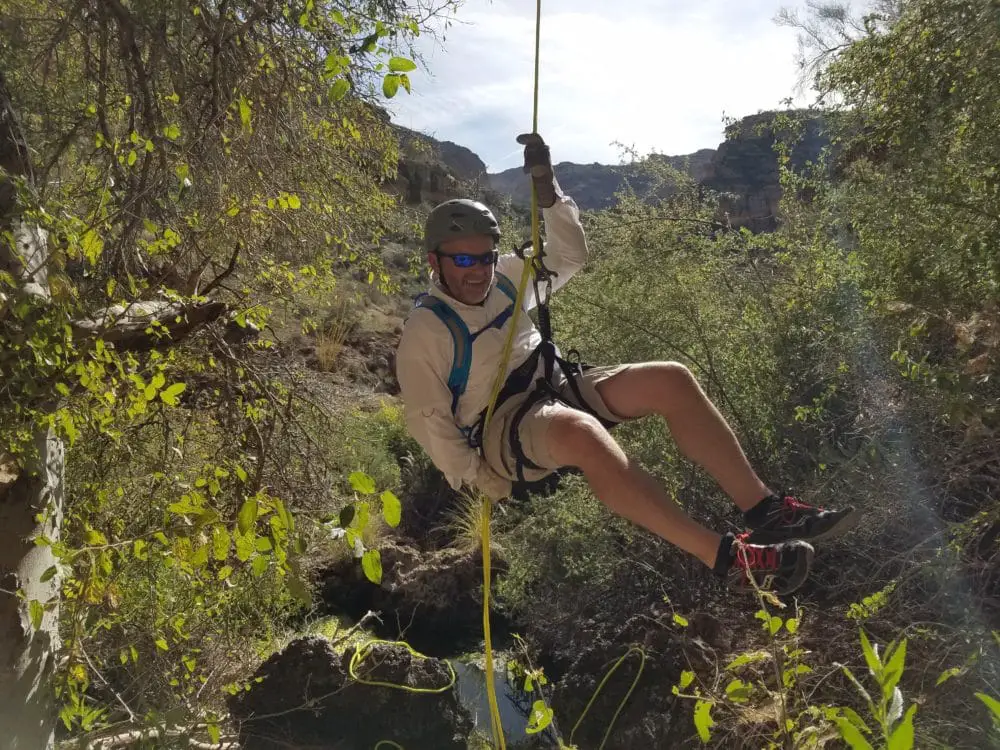
Summary
Hopefully all of this talk of flash floods and snakes and rockfall don’t deter you from going on a canyoneering adventure. Canyoning does involve a calculated risk, but you can weigh the odds in your favor by knowing what your up against and planning ahead. Planning ahead and gaining the technical expertise necessary will help significantly lower the overall risk of an accident.
See Also:
Top 5 Places to Canyoneer in Utah

